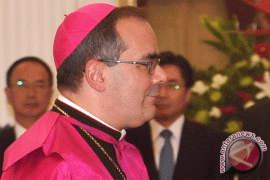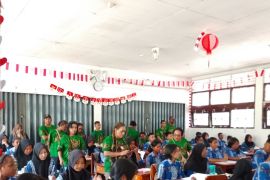... one thing the Asmat people need to know is that the local artworks, in the forms of carvings, have also been present at the Ethnographic Museum in Vatican."Jakarta (ANTARA News) - The annual Asmat Cultural Festival, which is currently underway in the easternmost province of Papua, is a great initiative and has its full backing.
Spearheaded by the Diocese of Agats-Asmat, the festival, which is being held at the Yos Sudarso Field in Asmat District from October 7 to 12 this year, marks the 31st anniversary of the event.
Asmat District Head Elisa Kambu said the Asmat Cultural Festival is a great initiative by the Diocese of Agats-Asmat. "This is the moment to continue to admire the work of the Supreme God, and the local government will continue to support and maintain it," Kambu said.
The highlight of this years festival is the cultural expressions of Papuas renowned Asmat tribe, which has been represented by 207 engraver artists and 102 traditional dancers. The festival has also been enlivened by 60 weavers and 88 rowers who are part of the rowing race along the Syirets river.
The bishop of the Diocese of Agats-Asmat, Mgr Aloysius Murwito, said the Asmat tribes culture should be preserved through such festivals. The festival, which has been an annual event since 1981, appreciates the various art forms of the Asmat people, their traditional dance -- an expression of what they feel and think -- and their way of life, which defines the tribes identity, Murwito said.
The Asmat Cultural Festival is packed with thousands of invited guests and international tourists who have a keen interest in anthropology, tribal art and the culture of Papua.
One of the main features of the festival is the communitys signature wood carving. The Asmat people are known for their unique ability in carving wood into beautiful works of art without the use of drawings or sketches. For them, these wood carvings are linked with the spirit world. Tribal warfare and ancestor worship are as important to them as showcasing their daily life and history.
The festival gives hundreds of artisans and performers the opportunity to showcase their skills in weaving, boating, and numerous traditional song and dance performances, which with the colorful costumes and the painted faces, are an amazing sight.
The festival closes with an display of Asmat artworks, which can be bought in an open auction.
In 2011, the UNESCO recognized Asmat District, located in the southern part of Papua facing the Arafura sea, as a world heritage site. Prior to this, way back in 1961, the region had attracted international attention when Michael Rockefeller, son of New York Governor Nelson Rockefeller, disappeared here whilst on an expedition, never to be seen or heard of again.
Besides the Asmat Cultural Festival, the Museum of Asmat Culture and Progress in the Asmat district town of Agats can also preserve the cultural values that will constitute the identity of the Asmat people, and also help them accept new things through a learning process.
Vatican Ambassador to Indonesia Mgr Antonio Guido Filipazzi inaugurated the Museum of Asmat Culture and Progress in Agats on Monday.
"As a representative of the Holy See, I would like to say that the Catholic Church is not only present in Asmat district, but one thing the Asmat people need to know is that the local artworks, in the forms of carvings, have also been present at the Ethnographic Museum in Vatican," Filipazzi remarked.
He noted that in every culture there is found truth, goodness, and artistic values that must continue to be preserved.
Thus, he added that the Asmat population is able to respond to new things, while maintaining their culture, and therefore the museum will be called the Asmat Museum of Culture and Progress.
The Asmat Museum was designed as a place in which the Asmat could look at their past and present, and partake of the environment of their culture, and form relationships with the housed artefacts.
The purpose of the museum is to prevent the Asmat from losing their identity.
Its most important contribution, however, is to expand and evolve the consciousness of the Asmat concerning the value of their past and their art.
Thus, the museum not only preserves the old, but revived carvings. In addition, it is a place of learning, where educational and recreational films and slides are viewed.
Made up of 193 ethnic groups that speak 193 different dialects, the population of Papua cannot be compared with any other region in Indonesia in terms of cultural diversity.
In other parts of Indonesia, modernization has resulted in profound changes in many aspects of the peoples life but in Papua much of the traditional social structures, tribal customs and arts of the Asmat, Ka Moro, Dani, and Sentani have endured.
Besides, the source of various local wisdom for humanity and better environmental management can be found among the tribes of Aitinyo, Arfak, Asmat, Agast, Ayamaru, Mandacan, Biak, Arni, Sentani, and others.
Ancient rituals are still performed for important social events in which each province and district has its own cultural festivals and shows for visitors and tourists to have the opportunity to glimpse the many visual and performing arts of Papua.
No wonder various efforts have been made to maintain and preserve the cultural diversity in Papua.
(T.O001/INE/KR-BSR)
Reporter: Otniel Tamindael
Editor: Priyambodo RH
Copyright © ANTARA 2016









